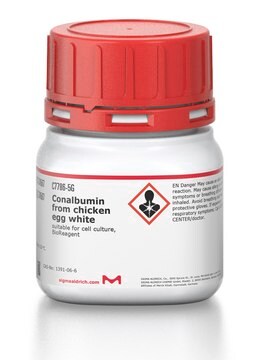추천 제품
생물학적 소스
bovine (Ruminant- Cow, Ox, Buffalo)
Quality Level
분석
≥98% (HPLC)
양식
powder
기술
HPLC: suitable
cell based assay: suitable
색상
white to off-white
유용한 pH 범위
5.0-7 (25 °C, 180 g/L)
mp
168-170 °C (lit.)
solubility
water: 180 g/L at 20 °C (68 °F )
응용 분야
cell analysis
genomic analysis
life science and biopharma
저장 온도
room temp
SMILES string
OC[C@@H](O)[C@H](O)[C@H](O)[C@@H](O)C=O
InChI
1S/C6H12O6/c7-1-3(9)5(11)6(12)4(10)2-8/h1,3-6,8-12H,2H2/t3-,4+,5+,6-/m0/s1
InChI key
GZCGUPFRVQAUEE-KCDKBNATSA-N
유사한 제품을 찾으십니까? 방문 제품 비교 안내
일반 설명
D-Galactose, the C-4 epimer of glucose and a pivotal mammalian monosaccharide, is widely present in blood, milk, gangliosides, and N- and O-linked glycans. It is ubiquitous in both plants and animals and acts as a constituent in diverse polysaccharides, including galactomannans, carrageenans, Agar (L-Galactose), Hemicellulose, and galactans. As an aldohexose, it serves as an energy source and a crucial element in glycolipids and glycoproteins. D-galactose undergoes enzymatic conversion into D-glucose for metabolism or polysaccharide storage, representing a C-4 epimer of glucose.
Furthermore, galactose is a fundamental component of the disaccharide lactose and is released through hydrolysis by β-galactosidase enzymes, playing a vital role in the survival and virulence of bacteria. In Escherichia coli, galactose is utilized through the Leloir pathway, with β-d-galactose serving as a carbon source and β-d-galactose inducing UDP-galactose synthesis for biosynthetic glycosylation. Galactose finds applications in researching metabolic disorders like galactosemia and serves as a substrate for enzymes involved in galactose catabolism, making it a valuable component in galactosyltransferase labeling buffer and a supplement in MRS broth for the growth of thermophilic lactobacilli.
Furthermore, galactose is a fundamental component of the disaccharide lactose and is released through hydrolysis by β-galactosidase enzymes, playing a vital role in the survival and virulence of bacteria. In Escherichia coli, galactose is utilized through the Leloir pathway, with β-d-galactose serving as a carbon source and β-d-galactose inducing UDP-galactose synthesis for biosynthetic glycosylation. Galactose finds applications in researching metabolic disorders like galactosemia and serves as a substrate for enzymes involved in galactose catabolism, making it a valuable component in galactosyltransferase labeling buffer and a supplement in MRS broth for the growth of thermophilic lactobacilli.
애플리케이션
D-(+)-Galactose has been used:
- as a supplement in SGal media to grow yeast strains to examine the role of different Ssa heat-shock proteins (Hsp70) isoforms in Hsp90 chaperoning functions
- as a carbon source in Biolog (MT2) microplate assay to test the ability of isolates to utilize carbon substrates
- to induce expression of membrane protein-green fluorescent protein (GFP) fusion in yeast
D-Galactose is an energy source and a metabolite that finds application in cell biology, metabolomics and biochemical research.
생화학적/생리학적 작용
Galactose is a simple monosaccharide that serves as an energy source and as an essential component of glycolipids and glycoproteins. Galactose contributes to energy metabolism via its conversion to glucose by the enzymes that constitute the Leloir pathway. Defects in the genes encoding these proteins lead to the metabolic disorder galactosemia.
Metabolism of D-galactose leads to the formation of reactive oxygen species (ROS) and results in oxidative stress and hepatocyte damage.
특징 및 장점
- Ideal for Metabolomics, Biochemical and Cell Biology research
- Versatile and adaptable for wide variety of laboratory and research applications
기타 정보
For additional information on our range of Biochemicals, please complete this form.
To gain a comprehensive understanding of our extensive range of Monosaccharides for your research, we encourage you to visit our Carbohydrates Category page.
Storage Class Code
11 - Combustible Solids
WGK
WGK 3
Flash Point (°F)
Not applicable
Flash Point (°C)
Not applicable
개인 보호 장비
Eyeshields, Gloves, type N95 (US)
이미 열람한 고객
Codruta Ignea et al.
Microbial cell factories, 10, 4-4 (2011-02-01)
Terpenoids constitute a large family of natural products, attracting commercial interest for a variety of uses as flavours, fragrances, drugs and alternative fuels. Saccharomyces cerevisiae offers a versatile cell factory, as the precursors of terpenoid biosynthesis are naturally synthesized by
Codruta Ignea et al.
Microbial cell factories, 15, 46-46 (2016-02-28)
Several plant diterpenes have important biological properties. Among them, forskolin is a complex labdane-type diterpene whose biological activity stems from its ability to activate adenylyl cyclase and to elevate intracellular cAMP levels. As such, it is used in the control
L Mortimer et al.
Mucosal immunology, 7(4), 829-841 (2013-11-21)
Entamoeba histolytica (Eh) is an extracellular protozoan parasite of the human colon, which occasionally breaches the intestinal barrier. Eradicating ameba that invades is essential for host survival. A defining but uncharacterized feature of amebic invasion is direct contact between ameba
Cheryl M Koh et al.
The Journal of clinical investigation, 125(5), 2109-2122 (2015-04-22)
Constitutively active MYC and reactivated telomerase often coexist in cancers. While reactivation of telomerase is thought to be essential for replicative immortality, MYC, in conjunction with cofactors, confers several growth advantages to cancer cells. It is known that the reactivation
Lu Han et al.
Biomaterials, 44, 111-121 (2015-01-27)
Multifunctional nanocomplexes (NCs) consisting of urocanic acid-modified galactosylated trimethyl chitosan (UA-GT) conjugates as polymeric vectors, poly(allylamine hydrochloride)-citraconic anhydride (PAH-Cit) as charge-reversible crosslinkers, and vascular endothelial growth factor (VEGF) siRNA as therapeutic genes, were rationally designed to simultaneously overcome the extracellular
자사의 과학자팀은 생명 과학, 재료 과학, 화학 합성, 크로마토그래피, 분석 및 기타 많은 영역을 포함한 모든 과학 분야에 경험이 있습니다..
고객지원팀으로 연락바랍니다.







